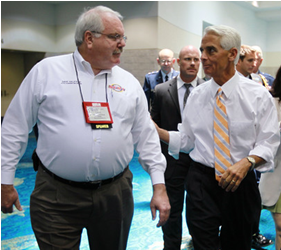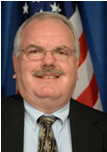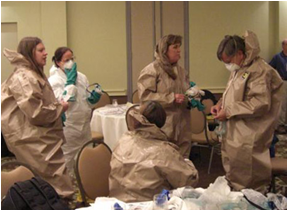
Vol. 6, No.10, October 2010 |
 Printer-Friendly PDF Version Printer-Friendly PDF Version |
2011 Florida SART Planning Meeting
Theme: Building a Better Team
 The Hilton Altamonte Springs - Orlando is the site of the 2011 Florida SART Planning Meeting.
The Hilton Altamonte Springs - Orlando is the site of the 2011 Florida SART Planning Meeting.
Registration for the 2011 SART Planning Meeting is now open. The meeting will be held February 28 – March 2, 2011 at the Altamonte Springs – Orlando North Hilton a Florida green hotel and conference center.
- Room rates for conference attendees are $93/per night.
- There is no event fee for registered participants, but you must register at www.flsart.org and book your room before January 28, 2011 at www.flsart.org/hotel to be eligible for the SART group rate.
- Planning meeting attendees are invited to a light fare reception the evening of February 28. Due to the generosity of several commercial sponsors, complimentary breakfasts will be served on March 1 and 2. On March 1 during the SART awards ceremony, lunch is also complimentary. (Generous sponsorships have been approved by ASPCA and Florida Farm Credit. Other sponsorships are pending.)
 | Photo left: David Halstead (l) with Florida Governor Charlie Crist. Photo below: David Halstead, Director of the Florida Division of Emergency Management.  |
- Was part of a 1992 Seminole County task force that responded to Miami-Dade County in the aftermath of Hurricane Andrew.
- Coordinated Florida’s emergency services assessment after the 9/11 attacks.
- Served as Emergency Services Branch Chief during the 2004 hurricane season.
- Was Chief of Domestic Preparedness for the FL Department of Law Enforcement in 2004, where he coordinated the working group for domestic preparedness in an all-discipline approach to terrorism.
- Helped lead 1,000 Florida responders into the southern counties of Mississippi immediately after Hurricane Katrina in 2005.
- He also serves as the State Emergency Response Team (SERT) Chief, managing operations of the State Watch Office and State Emergency Operations Center in Tallahassee, the alternate Emergency Operations Center, Domestic Preparedness Grants, Critical Infrastructure, and the State Logistics Response Center in Orlando.
Tentative 2011 Planning Meeting Agenda
Monday February 28 (1:00-5:00 pm)
- 1:00pm
- Welcome: Dr. Tom Holt and Seminole County
- USDA APHIS/Animal Care
- NASAAEP
- Division of Emergency Management Director Mr. Dave Halstead
- FACA President
- County Panel - Issues and Concerns
- (Palm Beach, Sarasota, Orlando, Monroe and Franklin)
- Close SART Chair
- 5:30 - 7:30 Mixer
Tuesday March 01 (8:00 am - 5:00 pm)
-
8:00 - 11:30
- Problem-solving Working Groups
- GROUP 1- Search and Rescue
- GROUP 2- Training Needs
- GROUP 3 - Transportation and Sheltering
-
Noon Awards luncheon - Speaker to be announced
-
Afternoon - Field training
- A. Large Animal Technical Rescue
- B. Animal Emergency Care
- C. MARE UNIT and Pet sheltering

Wednesday March 2 (8:00 - noon)
- 8:00 - Noon
- Canine Disease, a case study
- MOU between FVMA & FDOACS
- Florida SARC Report
- Florida veterinary stockpile plan
- Group Reports
- Responses
- Wrap-up and closing remarks
Questions may be directed to either Michael Turner(850) 410-6761 (turnerm@doacs.state.fl.us) or Joe Kight (kightj@doacs.state.fl.us). A Florida green hotel and conference center, the Hilton Orlando/Altamonte Springs has a web site at http://www1.hilton.com/en_US/hi/hotel/ALTAHHF-Hilton-Orlando-Altamonte-Springs-Florida/index.do
Why attend the 2011 SART Planning Meeting? After all, we haven’t had an emergency such as a hurricane or a devastating tornado in years and there has never been a terrorist attack on the agricultural system in Florida.
- - -
There has not yet been a terrorist attack on Florida’s food and water resources. While it is true that the storm fronts have given Floridians a break from nasty weather so far this year, those very tropical waves that can cause so much damage also replenish our water supply and, as of the date of this writing, Florida seems to be headed for a cycle of drought.
At a recent SART steering committee meeting John Haven, Director of UF’s College of Veterinary Medicine said, “There’s a lot of credibility in the SART name.” Please get involved now. Much remains to be done in organizing, training and networking.
Fall Agroterrorism Preparedness Classes
The Florida Department of Agriculture and Consumer Services (FDACS), Office of Agricultural Emergency Preparedness, partners with the Western Institute of Food Safety and Security (WIFSS) to present Department of Homeland Security (DHS) Certified Agroterrorism Courses.
All courses are free, run from 8:00 a.m. to 4:00 p.m. (unless otherwise specifically advertised) and lunch is provided, thanks to a DHS grant through WIFSS. Additional sponsoring partners include the Institute for Food and Agricultural Sciences (IFAS-Extension), the Florida Department of Health, and the Regional Domestic Security Task Forces.
AWR-154 Principles of National Incident Management System, Team Building, and Risk Communication
Tuesday, November 30
Fort Myers Regional Operations Center, 4700 Terminal Drive, Suite 6, Ft Myers, FL 33901
Wednesday, December 1
Sarasota County Government, Emergency Operations Center, 1660 Ringling Blvd, 6th Floor, Sarasota, FL 34236
AWR-155 Principles of Frontline Response to Agroterrorism and Food Systems’ Disasters
Wednesday, November 3
Division of Emergency Management, Palm Beach County, 20 South Military Trail, West Palm Beach, FL 33415
Thursday, November 4
Institute for Public Safety (Building 22), Broward College, Central Campus, 3501 SW Davie Rd., Davie, FL 33314
To register for a course or for more information go to the WIFSS website at:
Registration:
http://wifss.ucdavis.edu/agroterrorism/classes/classesbydate.php
Course Information:
http://wifss.ucdavis.edu/agroterrorism/classes/course_desc.php
Contact John Terry (850-410-6756 or terryj1@doacs.state.fl.us ) with questions.
Animal Disease Response Training


On Tuesday, October 26, FDACS’ Division of Animal Industry will host an Animal Disease Response Training session provided by the AgPreparedness Center https://www.agpreparedness.org. The course has been approved for 8 continuing education (CE) credits for Florida veterinarians.
The session will be held at the:
Florida Department of Agriculture and Consumer Services Conner Complex
3125 Conner Boulevard
Tallahassee, Florida 33435
8:00 AM to 5:00 PM
The Department of Homeland Security and USDA/APHIS have endorsed this course and determined that the materials are in compliance with existing National Animal Health Emergency Management System guidelines. These guidelines were established by USDA/APHIS for emergency response personnel in the event of a major animal disease emergency.
This course focuses on best practices and safety issues associated with an animal disease emergency. Participants will learn the importance of preparing for a potential outbreak and an awareness level knowledge of:
• Biosecurity
• Quarantine
• Personal protective equipment
• Euthanasia and disposal
• Cleaning and disinfection
For course information and syllabus: https://www.agpreparedness.org/course_description
For registration:
https://www.agpreparedness.org/11537.
This session is intended for federal, state and county employees only. For questions contact Gregory S. Christy, DVM (850) 410-0900, x 0902 christg@doacs.state.fl.us.
[top]
APHIS - Save Our Citrus


A seasonal information blitz in both English and Spanish by USDA/APHIS does not mean that you should begin hoarding oranges. Quite the contrary. Eat! Drink!
The Save Our Citrus campaign wants to increase awareness about the number of diseases threatening America’s citrus. In ‘08 and ‘09, the campaign focused on citrus greening. For 2010 it’s expanding to include canker and black-spot.
The theme “Don’t Risk Citrus, Don’t Move Citrus” communicates visually with a high-stakes pinball game illustrating how moving citrus plants can spread disease and wipe out entire orchards. This year the messages will run from October to March to create a sense of urgency and to encourage the reporting of citrus diseases.
To learn more and watch or listen to television and radio public service announcements (PSAs), check the web site (http://saveourcitrus.org). For more information, contact Greg Rosenthal at (301) 734-3265 gregory.j.rosenthal@aphis.usda.gov.
[top]
SART America

In the last few years many states have taken steps to develop coordinated all-hazard response capabilities, and a brief glance at web sites from around the U.S. helps us gauge how far along Florida has come in relation to other states.
The North Carolina SART web site at http://nc.sartusa.org/states/states.php has a great map of references. Of course, even though there certainly is competition for scarce funding and resources, a trained and coordinated response is not a competition. Think of it more as an investment in our future. Here are notes from a few random states, east and west:
- Alabama www.alsart.org
- An interagency effort to plan for agriculturally-related emergencies. The mission is to develop and implement procedures and train participants.
- Kansas www.kssart.org
- A non-profit organization building partnerships to facilitate local animal disaster preparedness and response development.
- Maine www.mainesmart.org
- Modeled after North Carolina and Colorado SART. Hurricanes are not an issue, but the listed contact is a telephone number in Denmark.
- New York www.empiresart.com
- “Because disaster response begins and ends at the local level, ESART promotes and supports the creation of County Animal Response Teams (CARTs).”

Dear Rick:
Our 3rd annual conference last weekend was a huge success! We had about 100 participants including vets/techs, ACOs, humane society workers, volunteers and EMs.
We offered classes that are both required and optional. Required classes included psychological first aid, human first aid and animal first aid. The psychological first aid was taught by a psychologist [who works in] a community health center and it seemed to be a favorite among the participants. They really like learning how to identify signs of stress in fellow responders and a bit about how to deal with issues arising from stress.
We also offered classes in Technical Animal Rescue (i.e. how to get a horse out of a frozen pond without killing it), wildlife handling during a disaster (lead by Kansas Wildlife and Parks....that was a fun one), legal issues surrounding disaster work, donations management (led by the Salvation Army), and organizational skills necessary for disaster work (led by the Kansas Nonprofit Chamber of Services; www.nonprofitchamberks.org/).
Our emphasis is a bit different [than Florida SART], but really not as much as one would think. We plan for large scale disasters in a different way as they include massive blizzards here, but we also have lots of flooding to plan for.The thing I take away from our conference every year is that the conference schedule is great, and it's very important. However, the simple act of getting people from across Kansas together PRIOR to a disaster is the single most important thing about these meetings. People then know each other prior to the disaster, which certainly makes any event go that much better.
Christen Skaer, DVM
Kansas State Animal Response Director
[top]
A Tough Fire Season Ahead?

A recent press release from FDACS predicted warm, dry weather for the Sunshine State. “Dry conditions coupled with a long-range forecast calling for a significant drying cycle threaten a potentially severe wildfire season.” The culprits are a lack (at least so far this year) of tropical storms over Florida and La Niña (cold sea surface temperatures in the Pacific Ocean).

The adage “Where there’s smoke, there’s fire” applies. But fire is a natural part of the ecosystem. When Smokey Bear stops fires he may save homes in one place but he may also permit the stockpile of fuel and interfere with natural plant succession and water flow in another. So this past year the Div. of Forestry http://www.FL-DOF.comconducted a great deal of controlled burning to reduce the flammable fuels in Florida forests.

FDACS recommends taking self-protection seriously by cleaning debris off roofs and gutters, keeping the area immediately next to their home free of vegetation and heavily watering within 30-feet should a fire approach.
Check your county's current wildfire danger at http://fdi.fl-dof.com.

[top]
Florida ESF Self-Test

In the world of emergency response and certainly working within the ICS system, it is important that we understand who has responsibility for what part of a disaster. In theory this clarifies lines of reporting and responsibilities, eliminates confusion and allows a more efficient response.
Match the ESF (Emergency Support Function) number with the correct responsibility. If you answer 15 or more correctly, score a huge Gold Star; 10 or more, a Silver Star and fewer than 10! BONUS: Match the departments and/or divisions below the box to each function. Answers at end of this month’s Sentinel.
| ESF# | Title or Responsibility |
1 | External Affairs |
BONUS: Match the Dept.s and/or Divisions with ESF responsibilities. WARNING: Some may have more than one or may share, and others have none at all:
Dept. of Transportation
Dept. of Management Services, Enterprise Information Technology
Dept. of Financial Services
Div. of State Fire Marshal
Div. of Emergency Management
Dept. of Business & Professional Regulation
Dept. of Children & Families
Dept. of Management Services, Div. of Purchasing
Dept. of Health
Dept. of Military Affairs
Florida National Guard
FL Public Service Commission
FL Energy and Climate Commission
Executive Office of the Governor
Governor’s Commission on Volunteerism & Community Service (Volunteer Florida)
Dept. of Law Enforcement
Dept. of Agriculture & Consumer Services
Office of Tourism, Trade & Economic Development
Dept. of Revenue
[top]
Webinar: Animal Resources and EMAC
Although I have frugally demurred from purchasing new software that opens “docx” files, I have entered the 21st century and have a ‘thank you’ note to prove it:
Thank you for attending "Animal Resources and EMAC." We hope that you enjoyed the session and that you will find the information about EMAC to be useful in your work.
You may download the slides used in the presentation at www.emacweb.org/?2285. (This is a large PDF file, so please be patient in downloading it.) Also, a recording of the presentation is now available at www.emacweb.org/?2287. Please share this link with anyone you know who may have missed the session but wants to know more about EMAC!
[Angela Copple acopple@csg.org is EMAC Program Director and Jennifer Perkins jpekins@csg.org is NEMA technology analyst.]

The “old ways” of learning are changing from conventional in-your-face classrooms to electronic classrooms and it is certainly a benefit having these distance-learning opportunities. After “sitting in” on this Webinar and reviewing the on-line materials I at least know this about EMAC, the Emergency Management Assistance Compact:
- That all 50 states, the District of Columbia, U.S. Virgin Islands, Guam and Puerto Rico have signed on.
- State law that enables sharing resources among member states for:
- worker’s liability compensation,
- tort liability and
- immunity and licensure reciprocity.
Warning that Webinars may give you a little too much freedom. I got up, made coffee, and returned and the teacher (Leon Shaifer – quite good, conversational, easy to listen and pay attention to) never knew – although I realized I might have missed something important and so have reviewed the material several times.
In response to my email with questions, Jennifer Perkins, NEMA EMAC Technology Analyst, wrote:
“A benefit of the virtual session is that attendees are not constrained to sitting at a desk, and you typically shouldn’t feel like you have to be staring at a computer screen.
“We strive to make sure that the presenter provides all essential information verbally and uses the slides primarily for illustration or backup. (Of course, there are instances in which the slides are instrumental: for instance, in teaching about designing Mission Ready Packages, the slides showing what the MRP template looks like are key to the attendees’ understanding, so attendees need to be watching the screen very closely in such Webinars.)
“In any event, the slides should not be just a regurgitation of the talk, and although even we at NEMA can improve in this respect, we are constantly working to make the presenter’s talk—and the audience’s questions—the crux of the Webinar.”
News Note: Hazardous Spill in Port Everglades
The deepest of all Florida ports Port Everglades in Broward County is a major US container port with more than 5,200 ships at call in a year; a significant petroleum storage and distribution hub; and a US Navy liberty port. The port is actually composed of land in three municipalities, Hollywood, Fort Lauderdale and Dania Beach and unincorporated Broward County.

According to a National Response Center Incident Description(http://www.nrc.uscg.mil/reports
/rwservlet?standard_web+inc_
seq=955782), hazmat crews were called to Fort Lauderdale on Sunday October 3 to remove two containers leaking sodium hydroxide solution onboard the ocean-going ship Veracruz Express.
Sodium hydroxide (Lye) or caustic soda (UN1823) is often used as a drain or pipe cleaner. It is an odorless white solid or a clear-to-milky solution. It reacts with water or moisture to produce large amounts of heat, and reacts with some metals to produce highly flammable hydrogen gas. It can cause irritation to the skin on contact and is considered an inhalation irritant.
[top]
About the SART Sentinel | ||||||||||||||||||||||||||||||||||||||
The SART SENTINEL is an E-mail newsletter prepared monthly by the members of the Florida State Agricultural Response Team. Past issues of the Sentinel are archived on the Florida SART Web Site, www.flsart.org. If you have a story or photo that you would like to have considered for publication in The SART SENTINEL, please contact the Editors. Editor: Rick Sapp, PhD, Technical Writer, Florida Department of Agriculture & Consumer Services, Division of Animal Industry [rsa5@cox.net] Associate Editor: Joe Kight, State ESF-17 Coordinator, Florida Department of Agriculture & Consumer Services, Division of Animal Industry [kightj@doacs.state.fl.us] [top]ANSWERS to Florida ESF Self-TestIn the world of emergency response and certainly working within the ICS system, it is important that we understand who has responsibility for what part of a disaster. In theory this clarifies lines of reporting and responsibilities, eliminates confusion and allows a more efficient response. “Failure,” says the Division of Emergency Management, “is not an option.” Match the ESF (Emergency Support Function) number with the correct responsibility. If you answer 15 or more correctly, score a huge Gold Star; 10 or more, a Silver Star and fewer than 10! BONUS: Match the departments and/or divisions below the box to each function. Answers at end of this month’s Sentinel.
Source: http://www.floridadisaster.org/publications/ESFposter.pdf [top] |
